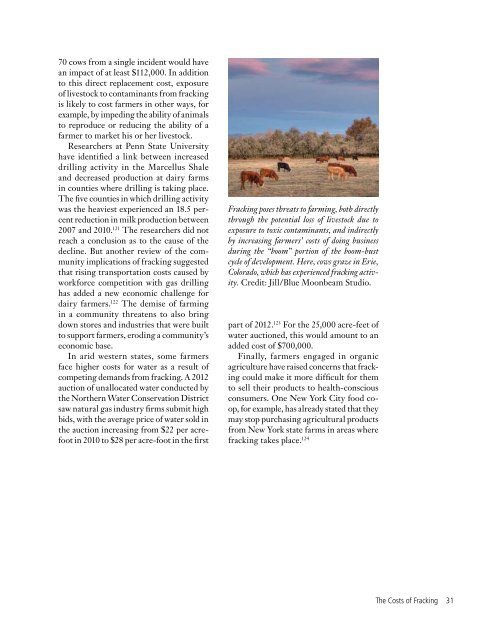The Costs of Fracking
The Costs of Fracking vMN.pdf - Environment Minnesota
The Costs of Fracking vMN.pdf - Environment Minnesota
You also want an ePaper? Increase the reach of your titles
YUMPU automatically turns print PDFs into web optimized ePapers that Google loves.
70 cows from a single incident would have<br />
an impact <strong>of</strong> at least $112,000. In addition<br />
to this direct replacement cost, exposure<br />
<strong>of</strong> livestock to contaminants from fracking<br />
is likely to cost farmers in other ways, for<br />
example, by impeding the ability <strong>of</strong> animals<br />
to reproduce or reducing the ability <strong>of</strong> a<br />
farmer to market his or her livestock.<br />
Researchers at Penn State University<br />
have identified a link between increased<br />
drilling activity in the Marcellus Shale<br />
and decreased production at dairy farms<br />
in counties where drilling is taking place.<br />
<strong>The</strong> five counties in which drilling activity<br />
was the heaviest experienced an 18.5 percent<br />
reduction in milk production between<br />
2007 and 2010. 121 <strong>The</strong> researchers did not<br />
reach a conclusion as to the cause <strong>of</strong> the<br />
decline. But another review <strong>of</strong> the community<br />
implications <strong>of</strong> fracking suggested<br />
that rising transportation costs caused by<br />
workforce competition with gas drilling<br />
has added a new economic challenge for<br />
dairy farmers. 122 <strong>The</strong> demise <strong>of</strong> farming<br />
in a community threatens to also bring<br />
down stores and industries that were built<br />
to support farmers, eroding a community’s<br />
economic base.<br />
In arid western states, some farmers<br />
face higher costs for water as a result <strong>of</strong><br />
competing demands from fracking. A 2012<br />
auction <strong>of</strong> unallocated water conducted by<br />
the Northern Water Conservation District<br />
saw natural gas industry firms submit high<br />
bids, with the average price <strong>of</strong> water sold in<br />
the auction increasing from $22 per acrefoot<br />
in 2010 to $28 per acre-foot in the first<br />
<strong>Fracking</strong> poses threats to farming, both directly<br />
through the potential loss <strong>of</strong> livestock due to<br />
exposure to toxic contaminants, and indirectly<br />
by increasing farmers’ costs <strong>of</strong> doing business<br />
during the “boom” portion <strong>of</strong> the boom-bust<br />
cycle <strong>of</strong> development. Here, cows graze in Erie,<br />
Colorado, which has experienced fracking activity.<br />
Credit: Jill/Blue Moonbeam Studio.<br />
part <strong>of</strong> 2012. 123 For the 25,000 acre-feet <strong>of</strong><br />
water auctioned, this would amount to an<br />
added cost <strong>of</strong> $700,000.<br />
Finally, farmers engaged in organic<br />
agriculture have raised concerns that fracking<br />
could make it more difficult for them<br />
to sell their products to health-conscious<br />
consumers. One New York City food coop,<br />
for example, has already stated that they<br />
may stop purchasing agricultural products<br />
from New York state farms in areas where<br />
fracking takes place. 124<br />
<strong>The</strong> <strong>Costs</strong> <strong>of</strong> <strong>Fracking</strong> 31



